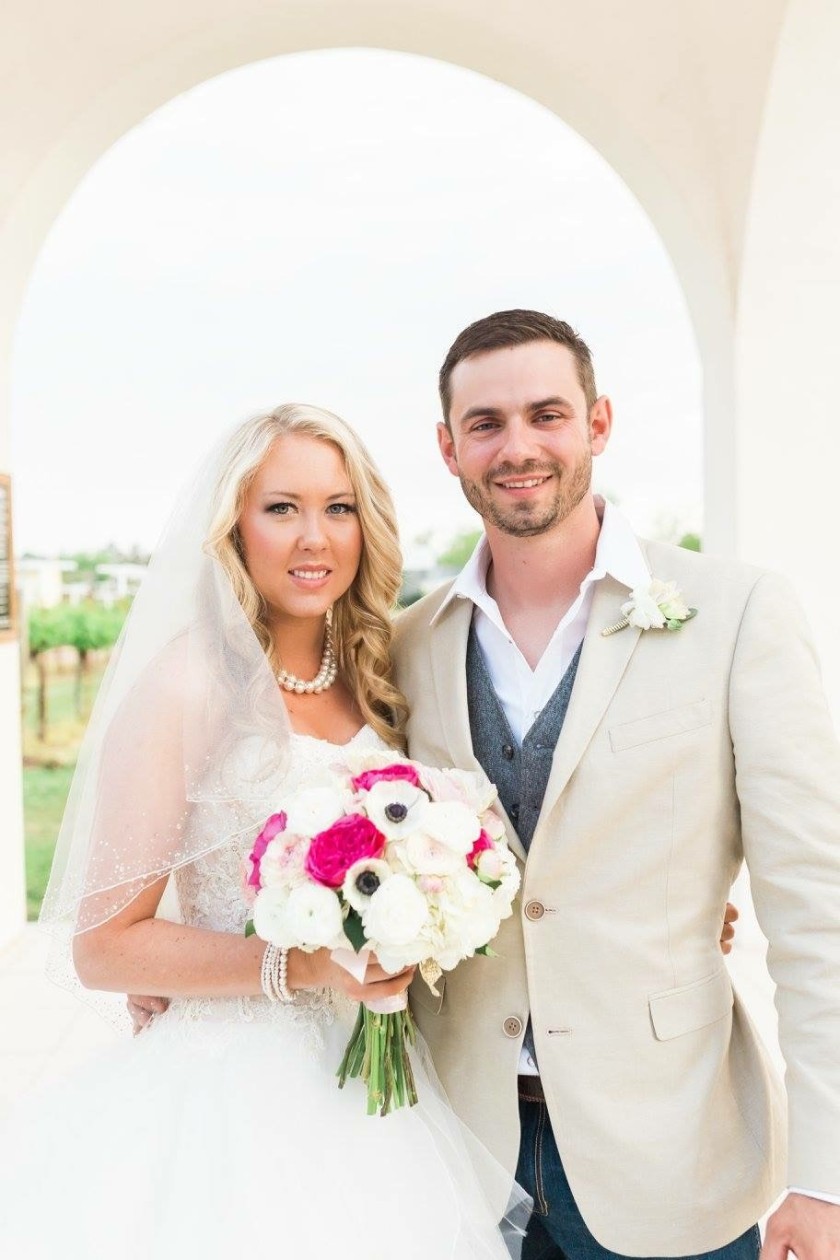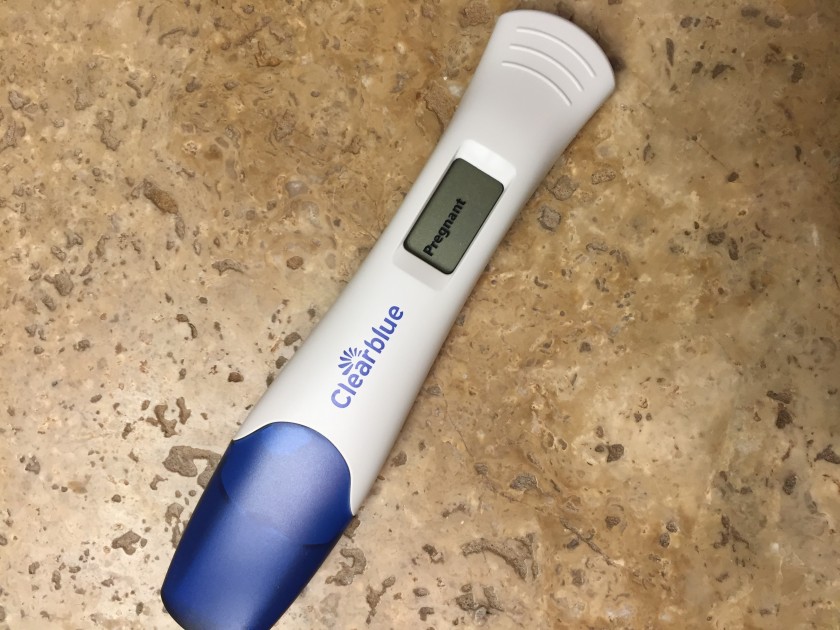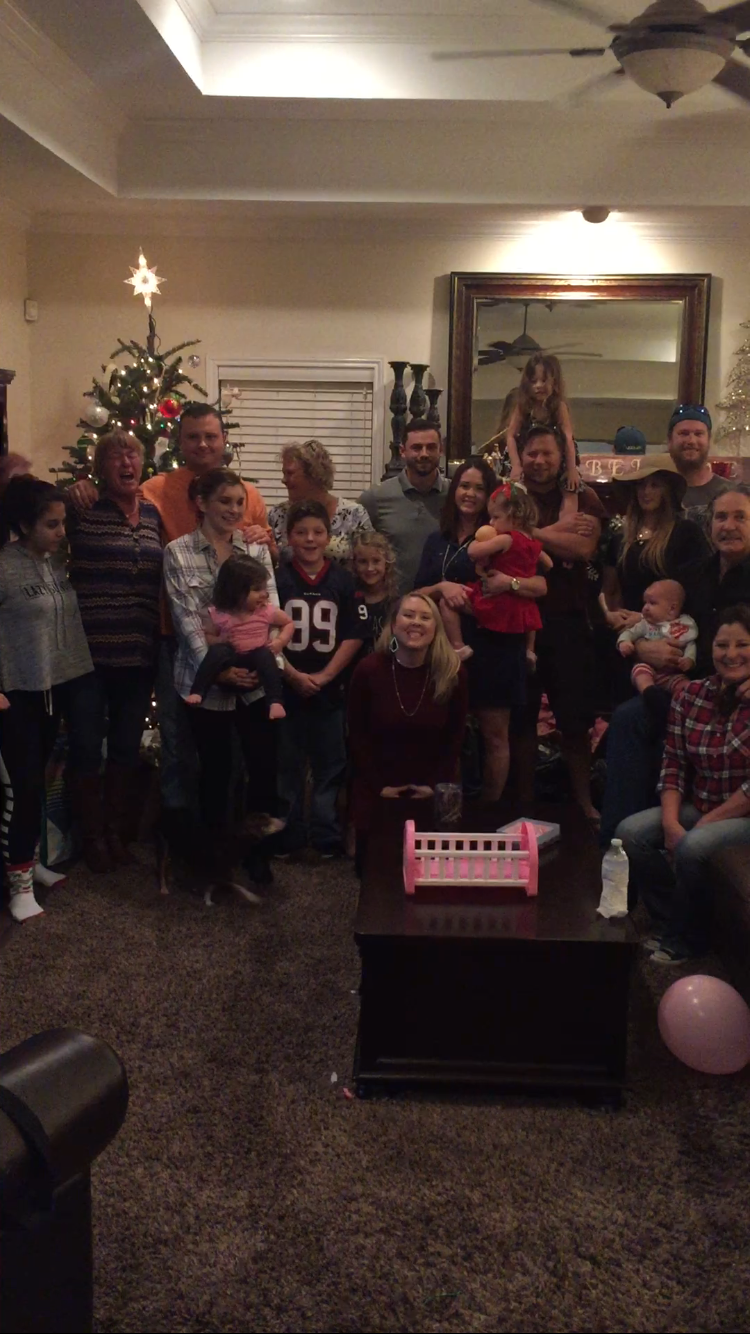March 29, 2017
I remember it like it was yesterday.
Our 18 week Anatomy Ultrasound was finally here! This would be the second Ultrasound we would receive. I was stoked to finally see what baby boy looked like. Clearly he wasn’t going to look like a little lima bean anymore.
We got into the room and the technician started getting to work. It was so amazing seeing him on that screen! It’s almost as if it took 18 weeks to finally feel like there was a baby in there!
He wasn’t cooperating (go figure) so the nurse had me flipping around on that table like a fish out of water to get him to move positions. He was facing my spine instead of outwards.
Nothing was getting him to move, so the nurse gave me a Capri Sun to chug. (YUCK)
She finally moved on to all his vital organs..
Spine, liver, kidneys, bladder, brain, arms, legs, bones…
Head. Shoulders. Knees and Toes.
ALL LOOKED GREAT!
As she made her way to his little heart, she said she couldn’t get a good picture of it. So after a few tries, she decides to call in another technician who had a little bit more expertise.
So he comes in and starts going at it..
Then started the awkward silence….
And in pops the Doctor.
MORE awkward silence with the occasional medical terms mumbling in-between breaths.
SOMETHING WASNT RIGHT..
My heart just sank into the table.
[insert anxiety here]
Now my body was trembling…
I couldn’t look at my husband. I didn’t want his facial expressions agreeing with my gut feeling.
“Do you have a history of heart defects in your family?” “Any genetic syndromes?” asks the Doctor.
From that question on, everything became fuzzy.
The trembling graduates to full body shaking.
My mind remembers bits and pieces from those moments on.
Thank God my husband was there to listen.
I remember the Doctor talking and I was just staring at him in a fog while tears stream down my face.
This is not happening right now.
What is he saying? We did genetic testing to make sure baby didn’t have any genetic conditions.. WE RECEIVED NEGATIVE RESULTS!
This is a bad dream..
“Well its a 50/50 chance the baby could have a chromosomal condition. You have the choice to do an Amniocentesis today if you would like to get further results. But with that said, we have to worn you there is a 1 in 400 risk of miscarriage from this procedure.”
He gave us the choice to think about it at lunch and come back and we could be seen that day before their offices closed for the next two days due to moving. If not, we could come back that following Monday morning and be scheduled.
“Whatever you do, do not use Google.”- the Doctor remarked.
I knew nothing about this procedure or a Congenital Heart Defect. He sent us on our way with the options for a referral to Texas Children’s Hospital or Children’s Memorial Hermann here in the Houston area.
PAUSE
Are you feeling like your lost too?? I damn sure was!
So we left and I called my sister immediately.
She could tell by the sound of my voice that something wasn’t right.
So I told her what I remember while my husband chimes in with the missing pieces.
“Shelley, it is still extremely early. Anything can happen at this point. His heart is still growing.”- my sister stated.
I asked her for her medical advice on an Amniocentesis procedure.
From that moment I decided I did not want to have that procedure done yet. I want to speak to the referring Pediatric Cardiologist for a second opinion. I just wasn’t willing to take that risk, nor was I in any mental state of mind to make that kind of decision. 1 in 400, THATS HIGH!
I have never been in that awful of a state of mind in my life. The thoughts that came across, the second guessing I was having. THE UNKNOWN ANSWERS I HAD.
I felt like a TERRIBLE human being for allowing those thoughts to conger up!
All these precautions we chose to take prior to starting a family, and the $900 blood test I chose to have at 10 weeks to rule out the genetic syndromes and tell me the sex of my baby… What was all that for now?!
Did that mean nothing?
Nolon and I chose to take the rest of the day off and go home and rest.
I went to work the next morning.
The girls at work knew something wasn’t right. I couldn’t talk to them. I didn’t want to talk about it. I didn’t know what to say, nor how to say it without crying hysterically.
I called my mom to tell her what was going on. I had to keep busy while waiting for the referral to call so we can set up an appointment for a second opinion.
I received the call from Children’s Memorial Hermann later that day. They needed to verify my insurance and could get me in Monday.
“Do you have anything sooner, like today, or tomorrow? I will pay upfront or whatever I need to do.” I pleaded.
Luckily, she was able to get me in Friday afternoon.
We showed up to our appointment. Nervous, anxious. EMOTIONALLY exhausted.
First appointment: Fetal Echocardiogram
Its pretty much a fancy ultrasound that can take a closer look at the baby’s heart and its functions.
Second appointment: Ultrasound
They took some regular shots to coincide with the echo to have a variety of different views to discuss.
Third appointment: Consultation with Pediatric Cardiologist and Genetics Consult.
We waited in a small room with a round table and a few chairs.
I called my sister to have her listen in on the consultation so she can pick up on any possible unanswered questions, and that way she knew what was going on and I wouldn’t have to try and explain it. (NOT MY FORTE). Its so much easier since she has a medical background as a RN and she can pass all the info to the rest of my worried family.
The two Doctors finally come in. Still not sure why there was two.
Here is the breakdown of what Children’s Memorial Hermann diagnosed Beau with:
Hypoplastic left heart syndrome (HLHS) is a rare congenital heart defect in which the left heart is severely underdeveloped. The International Working Group for Mapping and Coding of Nomenclatures for Paediatric and Congenital Heart Disease defined HLHS as[1]
In typical anatomy, the left side of the heart receives oxygen-rich blood from the lungs and pumps it to the rest of the body. In people with HLHS, the aorta and left ventricle are underdeveloped (beginning in utero),[2] and the aortic and mitral valves are either too small to allow sufficient blood flow or are atretic (closed) altogether.[3] As blood returns from the lungs to the left atrium, it must pass through an atrial septal defect to the right side of the heart so it can be pumped to the rest of the body. This blood must flow through a patent (open) ductus arteriosus. Since the ductus arteriosus usually closes within eleven days after birth, blood flow may be severely restricted and eventually blocked, leading to dangerously low circulation and, eventually, shock. Babies are often cyanotic at birth to varying degrees, depending on the severity of their defects.
There is no known cause in the majority of HLHS cases.[4] There is likely a genetic component, as HLHS has been shown to be heritable and associated with specific gene mutations.[5][6]
In a retrospective analysis of over 1,300 newborns (born between 1996 and 2006) from 24 children’s hospitals in the United States, researchers at Cincinnati Children’s Hospital in Ohio found that babies with HLHS were more likely to be born in summer months, suggesting that seasonality and environmental factors play a significant role in causation.[7]
Without life-prolonging interventions, HLHS is fatal, but with intervention, an infant may survive. A cardiothoracic surgeon may perform a series of operations or a full heart transplant. While surgical intervention has emerged as the standard of care in the United States, other national health systems, notably in France, approach diagnosis of HLHS in a more conservative manner, with an emphasis on termination of pregnancy or compassionate care after delivery.[10]
Before surgery, the ductus must be kept open to allow blood-flow using medication containing prostaglandin. Air with less oxygen than normal is used for infants with hypoplastic left heart syndrome. These low oxygen levels increases the pulmonary vascular resistance (PVR) and thus improve blood flow to the rest of the body, due to the greater pressure difference between the lungs and body. Achieving oxygen levels below atmosphere requires the use of inhaled nitrogen.[11] Nitric oxide is a potent pulmonary vasodilator, and thus reduces PVR and improves venous return. Any factor that increases PVR will impede right sided flow.[12][13]
Surgical operations to assist with hypoplastic left heart are complex and need to be individualized for each patient. A cardiologist must assess all medical and surgical options on a case-by-case basis.
Currently, infants undergo either the staged reconstructive surgery (Norwood or Sano procedure within a few days of birth, Glenn or Hemi-Fontan procedure at 3 to 6 months of age, and the Fontan procedure at 1 1/2 to 5 years of age) or cardiac transplantation.[14] Current expectations are that 70% of those with HLHS will reach adulthood.[8] Many studies show that the higher the volume (number of surgeries performed) at a hospital, the lower the mortality (death) rate.[15][16] Factors that increase an infant’s risk include lower birth weight, additional congenital anomalies, a genetic syndrome or those with a highly restrictive atrial septum.[citation needed]) For patients without these additional risk factors, 5 year survival now approaches 80%.[citation needed] Further, studies show that about 50% of those children who survived surgery in the early development of staged reconstruction have developmental delay or need special education; about 25% of these surgical survivors have severe disabilities.[citation needed] There is growing evidence that while the incidence of developmental and behavioral disabilities continues to be higher than that in the general population, children operated upon in the more current era have shown significantly better neurological outcomes.[citation needed] An alternative to the traditional Norwood is the Hybrid procedure.[citation needed]
Some physicians offer “compassionate care”, instead of the surgeries, which results in the child’s death, usually within 2 weeks of birth. Compassionate care is overseen by a physician, and may be carried out either in the hospital or at home. However, due to the vast improvement of surgical intervention, with many hospitals achieving over 90% survival, there is debate on whether or not “compassionate care” should still be offered to families.[17] A study in 2003 concluded that a selection of physicians who are experts in the care of children with HLHS were evenly split when asked what they would do if their own children were born with HLHS, with 1/3 stating that they would choose surgery, 1/3 stating that they would choose palliative (compassionate) treatment without surgery, and 1/3 stating that they are uncertain which choice they would make.[18]
The three-stage procedure is a palliative procedure (not a cure), as the child’s circulation is made to work with only two of the heart’s four chambers.
Norwood procedure[edit]
The first step is the Norwood procedure.[19] In this procedure, the right ventricle is used to pump blood into the systemic circulation. Since the right ventricle is no longer directly pumping blood to the lungs, a shunt is required in order to pass deoxygenated blood through the lungs. Either the subclavian artery can be connected to the pulmonary circulation (Blalock-Taussig shunt), or a shunt is made directly from the right ventricle to the pulmonary circulation (Sano shunt). The narrow aorta is enlarged using a patch to improve blood flow to the body.[20]
During this time the baby may be medically fragile and have feeding problems because the heart is working very hard. There is a considerable degree of venous mixing in the right ventricle, leading to lower oxygenation saturation. In addition, both the Blalock-Taussig and the Sano shunts expose the lungs to systemic arterial pressures, leading to long-term pulmonary hypertension and eventually heart failure.[19]
Hybrid procedure[edit]
The Hybrid procedure may be used in place of the Norwood.[19][21][22] The Hybrid procedure does not necessitate the use of heart-lung bypass or performing a sternotomy. Instead of a six-hour surgery, the Hybrid typically takes one to two hours. In this procedure, a stent is placed in the ductus arteriosus to maintain its patency, and bands are placed over both the left and right pulmonary artery branches to limit pressure and over-circulation to the lungs.[23] Outcomes with the Hybrid approach are comparable to those with the Norwood.[24]
Glenn procedure[edit]
The second stage—the bidirectional Glenn or Hemi-Fontan (see also Kawashima procedure)—relieves some of the problems introduced by Stage I palliation.[19] In this operation, the superior vena cava is ligated from the heart and connected to the pulmonary circulation. At this time, the Blalock-Taussig or Sano shunt is taken down. The lungs are no longer exposed to systemic arterial pressures, but much lower venous pressures. Although venous blood from the upper half of the body is no longer mixing with oxygenated blood in the right ventricle, there is still venous mixing from the lower half of the body, leading to some degree of oxygen desaturation.[19]
Fontan procedure[edit]
The final procedure, the Fontan procedure, completes the repair of the hypoplastic left heart.[19] Although there are several variations, the functional effect is to redirect venous blood from the lower body (through the inferior vena cava) away from the right atrium to the pulmonary artery. This should eliminate any mixing of oxygenated and deoxygenated blood in the right ventricle. The right ventricle performs the traditional job of the left, supplying the body with oxygenated blood, while the passive systemic venous pressure performs the traditional job of the right, passing deoxygenated blood to the lungs.[19]
READ FURTHER [https://en.wikipedia.org/wiki/Hypoplastic_left_heart_syndrome]
This is what they are expecting to be the outcome come birth for little baby boy.
To them, baby would need 3 open heart surgeries before the age of 3.
I’ll let that info sink in….
Hard to swallow huh?
OPEN HEART SURGERY ON A NEWBORN BABY?!?!
Then we met with the Genetics Counselor.
She went over all statistics and the breakdown of our family histories..
Amniocentesis was brought up again…
There is that procedure we just cant get away from..
We discussed this in more complex terms.
Lets explain what this invasive procedure consists of.
Amniocentesis (also referred to as amniotic fluid test or AFT) is a medical procedure[1] used in prenatal diagnosis of chromosomal abnormalities and fetal infections,[2] and also for sex determination, in which a small amount of amniotic fluid, which contains fetal tissues, is sampled from the amniotic sac surrounding a developing fetus, and then the fetal DNA is examined for genetic abnormalities. The most common reason to have an “amnio” is to determine whether a baby has certain genetic disorders or a chromosomal abnormality, such as Down syndrome. Amniocentesis (or another procedure, called chorionic villus sampling (CVS)) can diagnose these problems in the womb. Amniocentesis is performed when a woman is between 14 and 16 weeks gestation. Women who choose to have this test are primarily those at increased risk for genetic and chromosomal problems, in part because the test is invasive and carries a small risk of miscarriage. This process can be used for prenatal sex discernment and hence this procedure has legal restrictions in some countries. Amniocentesis was first introduced by American obstetrician Fritz Friedrich Fuchs and Danish gastroenterologist Polv Riis in 1956 for fetal sex determination and up to mid 1970s amniocentesis were done ‘blind‘. Doctors Jens Bang and Allen Northeved from Denmark were the first to report amniocentesis done with the guide of an ultrasound in 1972. Chorionic Villus Sampling (CVS) was first performed by Italian biologist Giuseppe Simoni in 1983. Now real-time ultrasound is used during all invasive procedures because it provides for the safety of the fetus and accuracy of results.
Before the start of the procedure, a local anesthetic can be given to the mother in order to relieve the pain felt during the insertion of the needle used to withdraw the fluid. After the local anesthetic is in effect, a needle is usually inserted through the mother’s abdominal wall, then through the wall of the uterus, and finally into the amniotic sac. With the aid of ultrasound-guidance, a physician punctures the sac in an area away from the fetus and extracts approximately 20ml of amniotic fluid. If used for prenatal genetic diagnosis, fetal cells are separated from the extracted sample. The cells are grown in a culture medium, then fixed and stained. Under a microscope the chromosomes are examined for abnormalities. The most common abnormalities detected are Down syndrome (trisomy 21), Edwards syndrome (trisomy 18), and Turner syndrome (monosomy X). In regard to the fetus, the puncture seals and the amniotic sac replenishes the liquid over the next 24–48 hours.
Early in pregnancy, amniocentesis is used for diagnosis of chromosomal and other fetal problems such as:
- Down syndrome (trisomy 21)
- Trisomy 13
- Trisomy 18
- Fragile X
- Rare, inherited metabolic disorders
- Neural tube defects (anencephaly and spina bifida) by alpha-fetoprotein levels.[3]
Amniocentesis is performed between the 15th and 20th week of pregnancy; performing this test earlier may result in fetal injury.[6] The term “early amniocentesis” is sometimes used to describe use of the process between weeks 11 and 13.[7]
Complications of amniocentesis include preterm labor and delivery, respiratory distress, postural deformities, chorioamnionitis, fetal trauma and alloimmunisation of the mother (rhesus disease). Studies from the 1970s originally estimated the risk of amniocentesis-related miscarriage at around 1 in 200 (0.5%).[8] Three more recent studies from 2000-2006 estimated the procedure-related pregnancy loss at 0.6-0.86%.[9] A more recent study (2006) has indicated this may actually be much lower, perhaps as low as 1 in 1,600 (0.06%).[10] Unlike the previous studies, the number in this study only reflects the loss that resulted from amniocentesis complications and excluded the cases when parents decided for an abortion following the test results.[9] In contrast to amniocentesis, the risk of miscarriage from chorionic villus sampling (CVS) is believed to be approximately 1 in 100, although CVS may be done up to four weeks earlier, and may be preferable if the possibility of genetic defects is thought to be higher.[11]
Amniotic fluid embolism has been described as a possible risk.[12]
SOURCE: [https://en.wikipedia.org/wiki/Amniocentesis]
Since I of coarse had to ask the one question I was most worried about.
“How many miscarriages have happened in result to Amniocenteses carried out here in your facility?” I asked.
“Zero.” she said.
That was the answer I needed to know.
My thought process behind this entire thing was this:
What would be my babies quality of life?? Does he have a genetic syndrome after all?
Or is this just an isolated heart defect??
My brain couldn’t handle having these two questions constantly eating at me.
I had the option to rule one out.
We know he has a heart defect… Now we wouldn’t know the severity of it until we are closer to birth, since throngs can change while baby is still in utero.
Nolon and I had a lot to take in during that weekend. We needed to decide if we wanted to go forth with this Amnio and the risks that come with it. And we both had the exact same question eating away at us. The uncertainty of this babies quality of life.
WE PRAYED ALOT.
I can honestly say, I have never leaned more on our faith in my entire lifetime.
We both went to Church that Sunday for the first time in a very long time. I cried the entire service. Afterwards, we prayed with the prayer team over our situation at hand.
First thing Monday morning, I called to let them know we had decided to proceed with the Amniocentesis procedure.
Lucky for me, they had an opening that afternoon. (which was best because it didn’t give me time to talk myself out of it.)
“Lay down flat on your back. Your husband can not be bedside. He will need to have a seat over there. This will feel like an ant bite and will only last 2 minutes. You may feel some pressure and it could persist afterwards. If we can not get the full 20ml out during the first insertion, we will have to go in for a second.” the nurse said.
Now anyone who knows me well, knows how much I LOATHE needles!
First off, THAT IS THE BIGGEST DAMN NEEDLE I HAVE EVER SEEN.
NOTE: NO LOCAL ANESTHETIC IS GIVEN
Secondly, they were only right about the ant bite part when the needle pierced my skin.. However, IT WAS NOT THE SAME FEELING WHEN IT WENT THROUGH THE TWO LAYERS OF THE SACS!!
THAT HAS BY FAR BEEN THE WORST THING I HAVE ENDURED IN MY LIFE. (so far, I’ll update you come birthing time)
Luckily they were able to get the full 20ml at one time, but that was the LONGEST 2 minutes of my life trying to sit still and not yank that needle out of my stomach!
I don’t know how I did not pass out on that table right then and there. I’m sure my husband felt awful watching me go through that. I definitely couldn’t watch the procedure. I just remember staring up and trying to keep breathing all while muttering “DEAR GOD” and “HOLY HELL” at the same time. (It probably sounded like I was summoning the devil!)
Ummm.. that’s not what I signed up for.
Wipe yourself off and your good to go they said. Go home and rest, no lifting. You can go back to work tomorrow if you feel okay. If you have a fever or chill, call us immediately.
They stuck a little band aid on it and Nolon and I were on our way..
No wheel chair, no help. NOTHING.
My husband helped me hobble to the elevators. Over the skywalk. Up to our parking garage and into the car.
At this time my phone was blowing up with texts from my mom and sister.
I told them we were out and on our way home so I can rest.
We would hear the first round of results in a few days and the full result takes two weeks to receive.
The first round could rule out Down Syndrome and the two Trisomy’s (13 & 18).
Got that call…
GOOD NEWS!!! NONE WAS FOUND!
THANK GOD.
These are some of the more severe syndromes. Trisomy babies unfortunately don’t make it to birth or if they do, they pass shortly after birth.
Now we wait for the full “micro array” breakdown of all 46 chromosomes. These results can take up to 14 days from procedure.
Got that call….
“Your baby has 46 beautifully perfect chromosomes and nothing was detected.”
OMG THANK YOU LORD!
That was the biggest weight off my shoulders. It made it worth the pain I endured just to know that we were not only in the clear, no complications with the procedure, but that our baby was completely healthy in every other aspect.
We could finally focus on the isolated heart defect.
So guess what we did next…
RESEARCHED, RESEARCHED AND RESEARCHED.
Found forums, Facebook groups, friends with babies that have CHD’s.
I requested to become a part of one of the groups and made my first post. My question was if the families went to Children’s Memorial Hermann or Texas Children’s Hospital.
30 people responded.
29 said Texas Children’s Hospital because it is ranked #2 in the nation.
Can you guess what I did next?
Yep, got a THIRD opinion.
We scheduled our referral appointment to Texas Children’s.
Picked up my sister from the airport so she can go with us to this appointment.
This appointment started off with a tour and breakdown of the facility.
Saw the NICU and all those babies pre-surgery. There was a mom with twins in an incubator who needed to gain weight before they can undergo their open-heart surgeries.
Surprisingly, I felt at ease seeing these babies. They looked calm and content. It seemed as peaceful as I could imagine.
Then we moved to the CVICU. This is where he would come post-surgery. There were only a few babies in there. Same thing, really quiet, babies looked calm. But these babies had bandages down their little chest cavities and a few more wires than the others.
I looked over to the corner and there was a mother sitting there next to her baby.
I immediately started tearing up.
I pictured myself in her place.
That’s going to be me. Sitting bedside helpless. Can’t breastfeed. Can’t change them. Helpless.
Each baby has 1 nurse assigned to them.
When most babies get to leave two days later to start their lives at home, these babies are luckily if they leave after the first surgery. Some stay for the first two because the first surgery is the highest risk. Having to be in a hospital for the first 6 months of life.
Not fair. But we know that God chose us to be this little babies parents and we are going to do EVERYTHING in our power to give him the best life.
We wrapped up the tour. It answered SOO many questions that I immediately felt better. Getting to see the process and what was going to happen settled easier with me.
Then came the Fetal Echocardiogram.
That was by far the longest one yet. It was an hour and half of lying flat on my back still as can be so they can get all the views needed to make their diagnosis. Beau was kicking the Doppler the entire time.
Finally the Pediatric Cardiologist called us in for the consultation.
“The diagnosis we have for your baby is Shones Complex. It is on the same spectrum as HLHS, but in terms of treatments. Worst case scenario, baby will need the same 3 surgeries as babies with HLHS. The left side of his heart is smaller than the right, but everything is still there (unlike HLHS babies) and could possibly be useable. I’m not sure if you would be interested but if you end up being a candidate, we have a trial going on that gives Maternal oxygen in hopes that the fetus’s left side grows enough to where it could be useable at birth, and only one surgery maybe needed.” the Doctor said.
WELL WHERE DO I SIGN UP?
I had already caught wind of this trial from a previous mom of a heart baby who had taken part in it and was so patient enough to explain it to me over Facebook. Her baby had the EXACT same diagnosis as ours. Her son’s heart grew just enough to where he only needed one surgery at birth to correct his defect. He is now 2 and thriving. Cutest little guy ever.
We were now patiently waiting for a phone call from the Doctor who is over this research trial to see if we are a candidate.
That call came through a couple days later…
We are definitely candidates. However, it is currently only a trial that they are trying to move back to a study so they can make it an open label and the mothers will know if they are actually receiving oxygen, or the placebo effect.
I do not understand why they still need a control (placebo effect=fake) if they show in the past studies that their have been growth! 6 out of 8 moms at birth their babies showed growth. The ones who did the oxygen more than the 8 hours needed, had better growth results.
So the current trial has been moved to oxygen at 24 hours a day but at a 40% intake level and is available at 26 weeks gestation and will proceed until birth.
HERE’S MY STRAND OF HOPE.
There is ONE thing I can do that can possibly help the outcome of Beau’s heart. You bet I am going to do it!
And I am going to wear that ugly nasal wire and wheel that tank around with PRIDE.
Yes there will be stares, and maybe the occasional questions.
She’s young, obviously pregnant, and is lugging around an oxygen tank…
What’s her story?














